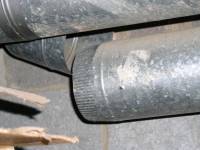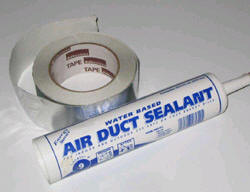Houses that are heated and/or cooled using a forced air system, have a network of air ducts that move the heated or cooled air from the furnace or air conditioner to the rooms of the home. The purpose of the air ducts is to circulate the air in a manner that will heat and cool the rooms in your home evenly.
A problem that is common in many homes is that the air ducts are not properly sealed and hence leak. These leaks can waste enormous amounts of energy. Some studies indicate that as much as 30% of the heating and cooling energy used in a home is lost through leaking duct work.
How do you know if your ducts need repairs?
There are numerous indications that the air ducts in your home are not properly sealed. They include:
- Rooms are not comfortable, they are either too hot or too cold
- Your utility bills in the summer and/or winter appear to be too high.
- The heating and cooling registers do not have much air flow.
- The air filters in your main air ducts need to be replaced more often than once a month due to a buildup of dust and dirt.
- There are noticeable dust paths from heating and/or cooling registers.
- Duct work that resides in attic or crawl space areas is not insulated.
- Ducts made of flexible materials have noticeable kinks or sharp bends in them.
Can a homeowner make duct repairs?

Figure 1 - Separated air duct
Working with ducts is not brain surgery! Most home handymen can make basic duct repairs and seal and insulate duct work.
Many heating and cooling ducts run in walls, however you can start by investigating the duct work that is visible in areas such as attics, basements and crawlspaces. In these locations you should be able to make basic duct repairs.
The first thing to look for is ducts that are no longer joined together, as shown in Figure 1. After reconnecting the duct, that was separated, use a small sheet metal screw to secure the connection and seal the joint with proper HVAC grade duct tape - not the grey tape that is called duct tape.
Once all the obvious broken or damaged joints are repaired you can check to see if there are any air leaks at other joints. To accomplish this turn on the heating and/or cooling system fan and place your hand near the duct work joints, if there is air leaking, you will feel it. If you discover any joint leaks seal them with the HVAC grade duct tape or duct mastic.
If you have air leakage where ducts penetrate ceilings or floors these can be sealed with a spray foam insulation. Of course, the areas in question:
Basements and
Crawlspaces should all be properly insulated.
The products that should be used to seal any air leakage in the ducts include those shown in Figure 2.

Figure 2 - Air duct sealing products
- A somewhat messy product that works extremely well is duct mastic. Make sure that you purchase mastic that is produced as a duct sealant.
- HVAC grade duct foil tape uses a thin piece of foil with an acrylic adhesive to provide adhesion to the duct. Note: Any products purchased to seal duct work should be approved under UL 181.
Another product that is being used is an aerosol sealant. It is sprayed inside the duct work, while it is under pressure, and follows the air leak and seals it. This type of sealant should only be installed by a professional HVAC contractor.
Check the duct insulation, if there isn't any insulation, or the insulation is damaged or in need of repair you should add duct insulation to a minimum of R-6. The insulation is important to ensure that the temperature of the air in the ducts is not lost as it travels from the fan unit through the home.
You can however, contract with a heating and cooling contractor to make the repairs and install insulation on your behalf.
There is a basic advantage to using a HVAC contractor to perform these tasks as they will have the necessary specialty diagnostic test equipment to verify duct pressure and air flows to ensure that your complete heating and cooling systems are working to there appropriate design criteria.
